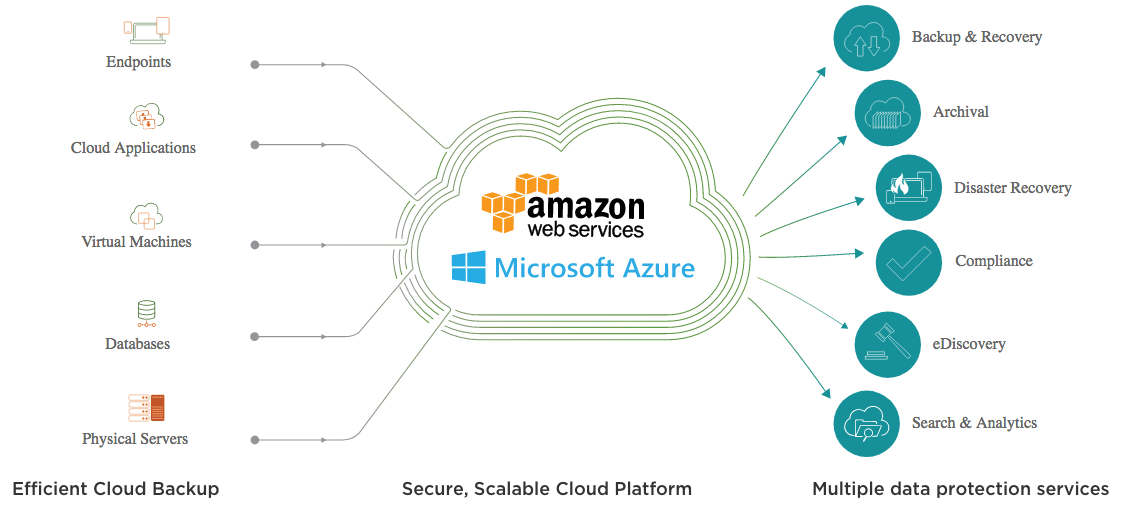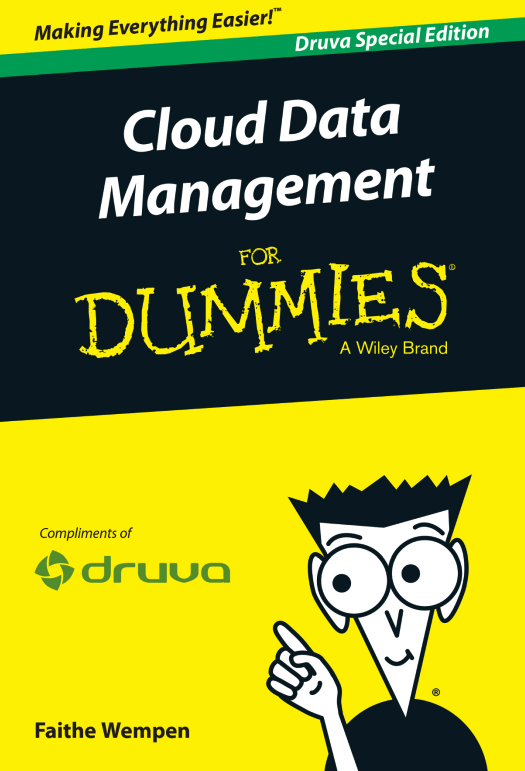A Cloud-Native Solution
Modern Cloud Information Management architecture is cloud‐native, meaning the technology is built from the ground up to leverage the benefits of the cloud. A true cloud‐native information management approach doesn’t simply cobble a cloud connection onto existing management systems but, rather, takes advantage of the unique features of the cloud to manage information in smarter, tighter, more efficient ways than were never attainable with traditional information management systems. Many cloud‐based services are more complex than simple applications, though — they are entire, integrated cloud stacks, typically including Software-as-a-service (SaaS), Platform-as-a-service (PaaS), and Infrastructure-as-a-service (IaaS). The integrated information management solution that Druva offers, for example, tightly binds elements of all three layers to optimize how data is captured and stored, how it is made available, and how it can be interconnected with other systems.
A Simplified Approach
Cloud information management systems can help navigate this complexity, providing a central access point, greater data visibility, less legal and regulatory risk, and cost savings. Here are the most important reasons to consider cloud information management for your enterprise.
Assurance of Comprehensive Data Collection — With individual data silos, IT managers have the nagging feeling (probably based in reality) they’re missing some data when they try to build a comprehensive collection. And even when they finally get a complete collection, it’s immediately out of date. A cloud-native platform reaches into all the places where enterprise data hides, from servers and desktops to tablets, smartphones, and cloud apps. They’ll know they are getting all the data.
Simplifies Backup and Recovery — Traditional backup systems can be slow, cumbersome, and expensive, both in terms of the hardware and the administrative costs. Because it stores a single, secondary copy of all data in the cloud infrastructure, backup hardware is no longer needed locally. And because it constantly updates according to a configurable schedule, it virtually eliminates the whole concept of performing a traditional backup. Backups, including historical ones from any point in time, are immediately available, ensuring fast recovery of your systems.
Works Across Locations Worldwide — Speaking of “anywhere in the world,” that’s what you get with a cloud information management system. Because the cloud is location‐agnostic, so is your access to it. Server crash? Your IT folks can restore its data just as easily from a taxi in Tangiers as from a desk in the datacenter.
Easy to Analyze Information for Trends — Because a cloud system indexes the full text of each data file, organizations can identify trends in data usage. A single dashboard provides access to the entire information management system, with summaries of activity by service, by user, by device, and by date.
Early Warning for Potential Data Access Anomalies — Constantly monitoring the company’s information systems manually for threats is inefficient, tiresome, and not cost‐effective. With a true cloud information management solution, managers can be alerted immediately and automatically when unusual activity is detected.
Ensures Compliance with Regulations — Relying on individual IT departments to manage information for complex and evolving compliance issues can put a company at risk, because people make mistakes. To make sure that all data storage conforms to applicable regulations about privacy, confidentiality, and retention, relying on a cloud information management system is a much smarter strategy. The cloud system can be setup to monitor for certain types of legal and regulatory compliance issues, and can send alerts whenever adjustments should be made.
Makes eDiscovery Quicker and Easier — Digging up the needed information when a company’s information is relevant to a pending lawsuit can be a time‐consuming task when data is distributed across many storage locations, but with cloud information management data is proactively collected, making the entire process quicker and easier.
Saves Money Compared to Other Options — Cloud‐based information management can save the average company 65 percent over a three‐year period in expenses related to information management, compared to traditional systems like hardware‐based backup devices and silo‐centric data analysis tools. Cost savings come from areas such as eliminating the need to:
- Buy and maintain backup and other information system hardware and software
- Store physical backup media off‐site and deliver it to or from that site daily
- Allocate IT staff to manage multiple information systems hardware and media
In contrast, a CIM system enables:
- Quicker recovery in the event of a server crash
- Dramatically reduced interruption and revenue loss
- Better managerial decision‐making due to increased data visibility
- Increased interception of potentially expensive data threats such as ransomware
- Lessened risk of fines or legal judgments resulting from mishandling data
Druva’s approach to Cloud Information Management ensures data availability and information governance across servers, endpoints and cloud applications. Policies are created and centrally managed by IT with granular settings down to file types and locations that are backed up, how disaster recovery will occur, and tiering of data for archiving in the cloud — without the heavy burden of infrastructure.
For more information, download our ebook:
Cloud Data Management For Dummies



